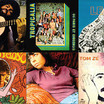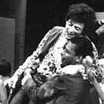Ruídos pulsativos

Geléia Geral
In April 1967, the collective exhibition New Brazilian Objectivity was held in the Museum of Modern Art, Rio de Janeiro – MAM/RJ. Organized by artists and critics such as Hélio Oiticica, Lygia Clark, Rubens Gerchman, Lygia Pape, Glauco Rodrigues, Carlos Vergara, Flávio Império, Nelson Leirner, Mário Pedrosa, Sérgio Ferro, and Waldemar Cordeiro, among others, it brought together various trends in the Brazilian avant-garde: concrete art, neo-concrete art, new shapes – around the idea of “new objectivity”. This notion originated in the theoretical writings of Hélio Oiticica on the situations of the arts and the avant-garde in Brazil. Oiticica defended the term “new objectivity” as being that which most faithfully translated the experiences of the Brazilian avant-gardes in general, and, in particular, his trajectory. For Hélio Oiticica, there was a tendency to pass beyond traditional platforms (painting, sculpture, etc.), to make use of environmental structures and objects.


The exhibition was a kind of summary of the various paths taken by Brazilian art until then. The creation of various kinds of objects as well as the defense of really Brazilian solutions that were not copies of those being produced internationally was the highlight of the event. In the taking of political positions, the passing beyond easel painting, and in the corporal, tactile and visual participation of the spectator, the new objectivity proposed a new action – and reaction – regarding art. In the words of Oiticica, the “new objectivity” was an “approach” constituting “multiple trends”. The diversity of works and paths indicated that the exhibition was, above all, a confluence of different esthetic tendencies, and not the launch of an artistic movement.
The exhibition, as well as the accompanying texts, can be read as a consequence of other events that had taken place in the 60s, such as the Opinião 65 and 66 exhibitions, in Rio de Janeiro. The collectively signed text that accompanied the exhibition, “The Declaration of Basic principles of the New Vanguard”, defended creative freedom, the use of a new language, the critical analysis of reality and the “use of means capable of reducing subjectivism to the maximum objectivity”.

Two large modules organized the New Brazilian Objectivity: the first oriented toward a retrospective of the object in Brazilian art that accentuated the “constructive vocation” of our artistic productions; the second dedicated to current manifestations. Among the anti-art pieces – Oiticica’s definition for the art being made at the time – marking the exhibition and remaining as references, we have the Caixa de Baratas (Box of Cockroaches), by Lygia Pape; and the relational objects, O eu e o tu (The I and the you) – roupa-corpo-roupa (clothes-body-clothes) and the máscaras sensoriais (sensorial masks), by Lygia Clark.  What marked the whole period, however, was the Tropicália environment by Hélio Oiticica. It consisted of a wooden labyrinth with a floor of sand and pebbles, with macaws and tropical plants, which at the exit terminated with a switched on TV set. The work ended up giving its name to the song written by Caetano Veloso, at the suggestion of filmmaker Luís Carlos Barreto, and to the Tropicalist movement itself. The long theoretical text on the exhibition and its artists, entitled “Esquema geral da Nova Objetividade” (“General Plan of the New Objectivity”) was also by Oiticica.
What marked the whole period, however, was the Tropicália environment by Hélio Oiticica. It consisted of a wooden labyrinth with a floor of sand and pebbles, with macaws and tropical plants, which at the exit terminated with a switched on TV set. The work ended up giving its name to the song written by Caetano Veloso, at the suggestion of filmmaker Luís Carlos Barreto, and to the Tropicalist movement itself. The long theoretical text on the exhibition and its artists, entitled “Esquema geral da Nova Objetividade” (“General Plan of the New Objectivity”) was also by Oiticica.
With its tropical, pop and avant-garde language – visible in Oiticica’s work, in Lindonéia by Gerchman and in record sleeves – the New Objectivity left its mark on Tropicalism.























